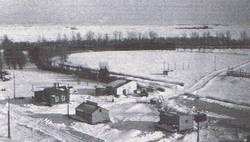Bringing trees and a recreational facility to a small prairie town

1906—Present
When Charles Sankey arrived in Waskada in the fall of October 1899, the townsite was totally devoid of trees. The prairie landscape that surrounded the town was decorated only by a scattering of farmhouses. Sankey was a dedicated community worker, and in fact appointed by the municipality to look after general public interests in the town.
The Vision of a Park
On a walk south of the townsite one day, a vision presented itself to Sankey: a recreational park, surrounded by trees, with space for sports activities and community events. From this initial dream, a combination of design, tenacity and some accident brought the Waskada Park into being.
The land south of the tracks was vacant, and Sankey applied to the CPR to gain use of the land. The railway company was not interested in having a town on both sides of the tracks, but agreed to sell 30 acres of land to the town to be used as a park. The down payment was paid by Sankey himself, along with a few other community members. The rest of the cost was paid by the town – a total of $900 ($30 per acre) – over the next few years.
Sankey then approached Frank Temple, who owned the land around the park and arranged to trade 2.5 acres on the southeast corner, for 2.5 acres on the east end. With this extra property the complete bend of the creek was within the park boundary. The creek bed was later dug out for swimming.
Planting Trees
The next improvement to take place in the park was planting trees. Sankey made an agreement with Mr Chambers who plowed up the strips of land where the trees were to be planted. Over the next two years funds were being gathered for the purchase of trees. In the meantime Chambers planted potatoes and other vegetables in the strips of land. He did an excellent job, and left the soil in good condition for receiving trees.
Trees from Patmore Nursery in Brandon arrived: maple, yellow willow, laurel willow and seedlings of ash, cottonwood and caragana. The CPR donated 1000 Russian Poplar to be planted along the north edge of the park to keep the snow off the railway tracks. From local residents a few silver leaf poplars were obtained, along with some elm and native chokecherry bushes. The summer after the planting was a fine one and every single tree grew.
Activities at the Park
A St. Patrick’s day concert was held at the park every year to help pay for improvements to the grounds. A levy was also put on activities that took place in the park, 10% of gate sales going to the town for upkeep of the park.
Over its more than one hundred year history, many activities have taken place in the park: horse racing, football, golf, skating, and of course baseball. After 1922 the Waskada Agricultural Society used the grounds, erecting an exhibition hall, poultry barn, buildings for stock and pens for pigs and sheep. Many excellent fairs were hosted on the grounds, though they were eventually put out of business by the drought of the 30’s and the technological advancements facing the agricultural industry. Interest in horse racing decreased after most farms took up motorised farming as opposed to using horse power. The buildings were dismantled and incorporated into the rink.
In 1962 a plaque was unveiled by the west gate, commemorating Sankey as well as others for their role in developing the park.
In the 1970s improvements were made to modernise the park facilities. The Lions Club partnered with the town council to replace the privy on the grounds with flush toilets. The town council also started a small trailer camping area in the park. A road was gravelled and electricity brought over from the grand stand to provide a light and plugs for trailers.
. . . . .
Related Articles:
. . . . .
Author: Teyana Neufeld, 2013.
Sources:
Sankey, Charles. “Waskada Park.” Bridging Brenda Vol I. Brenda History Committee. Altona: Friesen Printers, 1990. Pgs 346-7.
Jones, Frank. “Park Update.” Bridging Brenda Vol I. Brenda History Committee. Altona: Friesen Printers, 1990. Pgs 347-8.
Photo: Brenda History Committee. Bridging Brenda Vol I. Altona: Friesen Printers, 1990. Pg 346.
